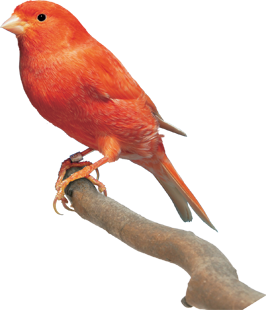Profiles
CANARY
It is more difficult to breed canaries than it is to breed budgerigars.
Canaries have much more fastidious feeding and husbandry requirements during the breeding season. However, with a bit of time and care, it can be very rewarding to breed your pet canaries.
The entire process from the time the eggs are laid until the day the chicks become fully independent takes around two months. It is preferable to breed canaries in cages rather than in an aviary. These birds like a bit of privacy. To avoid disturbing the breeding pair, their cage should not be facing any other birds. Breeding cages should have a removable mesh partition down the centre. This allows you to separate the birds until they are ready to mate but still lets the male act out part of his courtship, which involves feeding the female.
Sexing:
The only way to reliably distinguish male from female canaries is by their singing. The males are the songbirds. The intensity and volume of their song increases as they reach peak breeding condition. The females unfortunately do not produce the same melodious songs as their mates but you will be able to tell that they are getting ready to breed when they start to appear restless and begin exhibiting nesting behaviour.
Timing:
The ideal time for your canary to breed is largely determined by the weather, which means canary breeding season can vary from State to State. For example, canaries throughout New South Wales and Queensland will generally be in season from August/September until December/January. However, the Victorian breeding season runs from late August/early September until to December/early January. South Australia canaries typically start showing signs that they are ready to breed in September and will remain in season until December or early January at the latest.
Nesting:
Canaries nest in open-topped pans, which can be made from materials such as metal, plastic or earthenware. The nesting pans should be lined with a soft material such as felt as well as additional nesting materials that the female can weave into a nest. Shredded tissue paper, cat hair, hay, moss, cotton wool or rags are all materials that she can put to good use. Whatever nesting material you use, the strands must be short so that your bird's feet do not get tangled up in it.
Egg Laying:
Canaries usually lay four or five eggs, although they can lay as few as two or as many as six. The eggs are laid one a day, or one every other day. They are always laid early in the morning. Canary eggs are pale blue with tiny brown specks. If they are allowed to hatch in the same order that your bird laid them, the chicks will be at different stages of development while in the nest. This is harder work for the parents than raising a brood of chicks that are all around the same age and size.
To avoid this situation and make it easier on your birds, you can remove the eggs from the nest during the laying period then replace them when the clutch is complete. This way all the eggs will incubate for the same length of time. Remove each egg from the nest at around noon on the day that it is laid and replace it with a dummy egg. You can purchase dummy eggs at your pet shop. Once removed, the eggs can be kept at room temperature on cotton wool for up to two weeks. Once the hen has finished laying all of her eggs, you can put the eggs back in the nest and take the dummy eggs out. Incubation will then begin and will last for 13 to 14 days.
Diet:
Female canaries can be fed soft foods for two weeks prior to breeding and throughout the breeding season. There are a number of commercial rearing or conditioning soft foods that you can buy, although many breeders also make up their own mixtures from a variety of ingredients. Cuttlefish bone and grit are important sources of additional calcium that you should provide for your birds during the breeding period.
Care of the young:
Canaries are born naked and blind and are completely dependent upon their parents for food as long as they are in the nest. Soft rearing food can be introduced to the young on the second day after hatching. At around 16 days old, they will leave the nest and commence learning to feed themselves. Occasionally male canaries will attack their young so you should keep a keen eye on the parents during the delicate rearing period. The chicks should be able to fully feed themselves at around 25 to 30 days old. At that time, they are ready to be separated from their parents.
